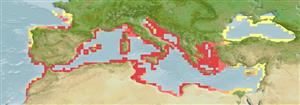>
Eupercaria/misc (Various families in series Eupercaria) >
Labridae (Wrasses)
Etymology: Symphodus: Greek, syn, symphysis = grown together + Greek, odous = teeth (Ref. 45335).
More on author: Linnaeus.
Environment: milieu / climate zone / depth range / distribution range
Ecología
marino; salobre asociado a arrecife; rango de profundidad 1 - 50 m (Ref. 121253). Subtropical; 47°N - 21°N, 11°W - 42°E
Eastern Atlantic: Spain to Morocco including the Mediterranean and Black Sea.
Length at first maturity / Tamaño / Peso / Age
Maturity: Lm 11.7, range 12 - 15.2 cm
Max length : 44.0 cm SL macho / no sexado; (Ref. 3397); common length : 25.0 cm SL macho / no sexado; (Ref. 3397); edad máxima reportada: 15 años (Ref. 4742)
Short description
Claves de identificación | Morfología | Morfometría
Espinas dorsales (total) : 15; Radios blandos dorsales (total) : 11; Espinas anales: 3; Radios blandos anales: 12.
Adults are found near rocks mainly in eel-grass beds, sometimes in salty lagoons. Often gregarious. Oviparous (Ref. 205). Nest of seaweed built and kept by male with one or more females spawning. Feed on sea urchins, ophiuroids, bivalves, shrimps and crabs (Ref. 4742). Rate of growth is slow (Ref. 4742). Undergoes sex reversal (Ref. 4742).
Life cycle and mating behavior
Madurez | Reproducción | Puesta | Huevos | Fecundidad | Larva
Oviparous (Ref. 205). One male makes a nest of seaweed for one or more females to spawn in (Ref. 4742). Undergoes sex reversal (Ref. 4742).
Quignard, J.-P. and A. Pras, 1986. Labridae. p. 919-942. In P.J.P. Whitehead, M.-L. Bauchot, J.-C. Hureau, J. Nielsen and E. Tortonese (eds.) Fishes of the north-eastern Atlantic and the Mediterranean. UNESCO, Paris. Vol. 2. (Ref. 4742)
IUCN Red List Status (Ref. 130435: Version 2024-1)
Threat to humans
Harmless
Human uses
Pesquerías: pesquerías de subsistencia; pesca deportiva: si; Acuario: Comercial
Herramientas
Special reports
Download XML
Fuentes de Internet
Estimates based on models
Preferred temperature (Ref.
123201): 16.3 - 21.4, mean 18.9 °C (based on 116 cells).
Phylogenetic diversity index (Ref.
82804): PD
50 = 0.5005 [Uniqueness, from 0.5 = low to 2.0 = high].
Bayesian length-weight: a=0.00933 (0.00780 - 0.01116), b=3.04 (3.00 - 3.08), in cm total length, based on LWR estimates for this species (Ref.
93245).
Nivel trófico (Ref.
69278): 3.3 ±0.3 se; based on diet studies.
Resiliencia (Ref.
120179): Medio, población duplicada en un tiempo mínimo de 1.4-4.4 años (K=0.25-0.89(?); tm=2-3; tmax=15).
Fishing Vulnerability (Ref.
59153): Moderate vulnerability (40 of 100).
Nutrients (Ref.
124155): Calcium = 27.3 [12.3, 58.4] mg/100g; Iron = 0.547 [0.298, 1.074] mg/100g; Protein = 19.5 [16.6, 21.7] %; Omega3 = 0.22 [0.13, 0.38] g/100g; Selenium = 14.8 [7.1, 28.4] μg/100g; VitaminA = 50.1 [14.3, 214.1] μg/100g; Zinc = 1.02 [0.67, 1.79] mg/100g (wet weight);
